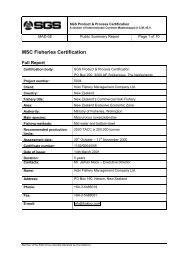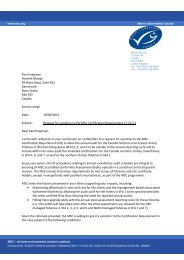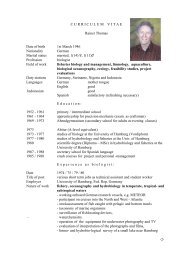SGS Product & Process Certification - Marine Stewardship Council
SGS Product & Process Certification - Marine Stewardship Council
SGS Product & Process Certification - Marine Stewardship Council
You also want an ePaper? Increase the reach of your titles
YUMPU automatically turns print PDFs into web optimized ePapers that Google loves.
4.2 Discarding. Quote ―The client fishery is a very clean fishery, and all species caught are retained species. There is no discarding of non-retained<br />
species.‖ This is a rather emphatic statement. Are there no undersized bass, cod or saithe caught and discarded (these are retained species, by the<br />
MSC definition)? Are all gurnards retained? 1)We will ask the client, but seem to remember that that was their answer. 2) Which was confirmed by the<br />
client, any numbers will be very limited anyhow.<br />
See comment against 2.2 in the scoring table which draws attention to several inconsistencies regarding discarding.<br />
Scoring comment (below) 2.2.3 implies that there is discarding of undersized bass, cod, and saithe by the client fleet. Is there any independent<br />
verifiable information on the discarding behaviour of the clients at sea? No? There are no audit trace references given in the Scoring Table.<br />
Jan Willem Wijnstroom, Sportvisserij Nederland in Appendix D states ‖VBHL fishermen apply a bigger mls which is the right step in the direction.‖ This<br />
implies that VBHL fishermen are discarding bass which do not meet their self-imposed higher MLS. Actually, it implies that they are fishing in areas<br />
where small bass (which are valuable if >MLS) are infrequent. If this is so then the whole question of discarding target species needs to be revised<br />
throughout the report and scoring table. The report has been amended in response to a similar comment by the other referee. Discarding of the target<br />
species is only important if it results in mortality that is significant in terms of sustainability. Clearly, this is not the case in this fishery and is covered by<br />
the RBF under PSA Susceptibility attributes and scores.<br />
5.1 Legislation and regulation. Quote ―In France, a national regulation limiting bass landings by French pelagic trawlers fishing in the English Channel<br />
was set up in 1996, and sea bass landings by all trawlers have been limited to 5t/boat /week from 1 January to 30 April since 1998.‖ But presumably<br />
this does not apply in the southern North Sea where French landings (Table 1) have increased in recent years. Yes it does.<br />
5.2 Roles & Responsibilities. Quote ―The North Sea Demersal RAC has greatly improved effective communication links between industry, NGO‘s,<br />
managers and scientists.‖ Has bass ever been discussed is the RAC? If yes, what was the outcome? It is doubtful: bass continues to be a target<br />
species only for small boats and a by catch species for larger vessels, and there are no stock, TAC, or quota concerns.<br />
Quote ―The most important working group when considering sea bass is WGNEW, which ICES established in 2005 to provide the EC with advice on<br />
stock status and management of so called MoU (Memory of Understanding) species.‖ Yet there has been little output referred to in this report. Have<br />
they seriously looked at bass? Not since 2004, the last year that the ICES Sea Bass Study Group existed (superseded by WGNEW). If yes, then there<br />
should be more ICES input in this report.<br />
5.4 Monitoring, Control and Surveillance. Quote ―After entering a port, fishing vessels have to deliver a logsheet with all landed quantities and<br />
species to the AID (in a special post box).‖ So why are there no data from this source presented here? Only data given was sourced from the clients<br />
(Table 2). AID information is not made public<br />
Page 126 of 151





